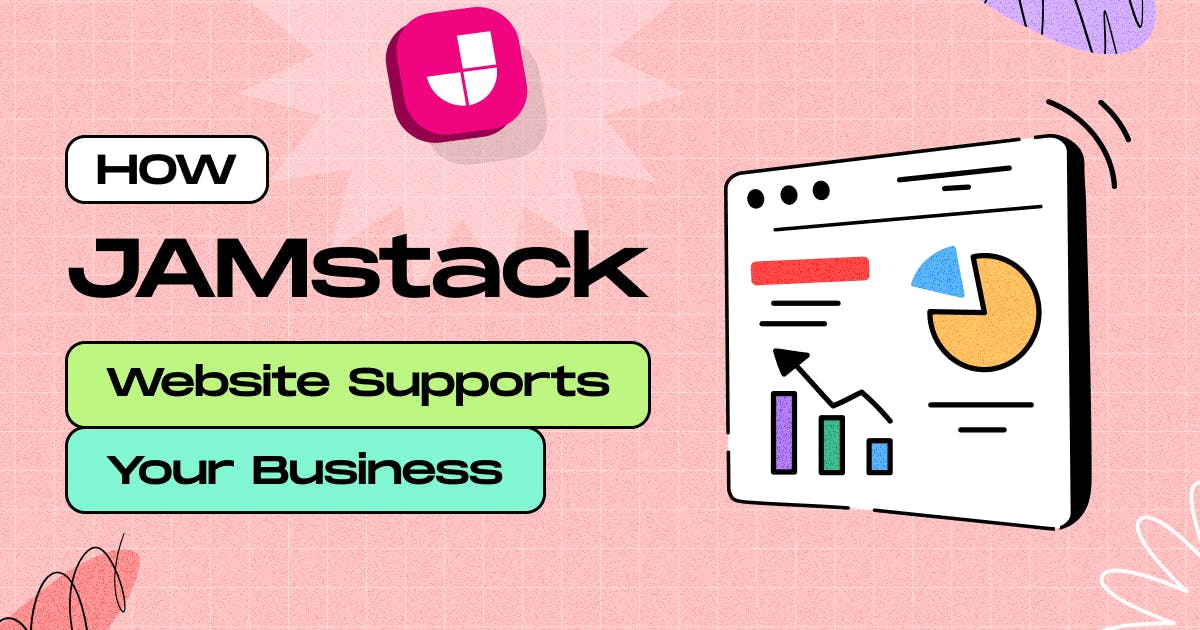September 24, 2023
How A JAMStack Website Supports Your Business

Md. Saad

In today’s digital landscape, simply having a website isn’t enough—your site needs to be fast, secure, and scalable to stand out. That’s where Jamstack comes in. Short for JavaScript, APIs, and Markup, Jamstack architecture offers a modern alternative to traditional website development, helping businesses build high-performing websites with better flexibility and reliability.
Jamstack websites serve pre-rendered static assets, reducing server load and improving speed. According to Google, a one-second delay in page load time can reduce conversions by up to 20% (Think with Google). By decoupling the frontend from the backend, Jamstack enables faster performance and stronger security, key factors in today’s competitive online environment.
For e-commerce and content-driven sites, the benefits are even more apparent. A 2023 report from Netlify highlighted that Jamstack websites saw 50% faster load times and a 25% drop in maintenance overhead compared to traditional stacks. With no direct connection to a database at runtime, Jamstack also significantly reduces attack surfaces, making it a more secure choice for businesses handling sensitive data.
By embracing a Jamstack approach, you're not just keeping up—you're building a site that’s ready for where the web is headed.
Fast, Secure & Scalable Websites Built for Modern Business Success
If you’re running a business in the US or over the world—whether you're in retail, SaaS, or local services—your website isn’t just a digital placeholder. It’s your storefront, sales team, and customer service desk all rolled into one. And that’s exactly why more companies are shifting to Jamstack websites.
So, why use Jamstack? Unlike traditional monolithic architecture, Jamstack decouples the frontend from the backend. This means your website loads faster, scales effortlessly during traffic surges, and is much more secure by design. According to a 2024 report by Netlify, businesses using Jamstack saw 40% improvement in page speed and lower hosting costs by 32% over a 12-month period.
Here’s how a Jamstack site supports your business goals:
- Performance and Speed
Jamstack websites serve pre-built files via CDNs, leading to near-instant page loads. Google reports that a delay of just 1 second in mobile load times can impact conversion rates by up to 20%. Faster load times also improve Core Web Vitals, which directly influence SEO rankings. - Scalability
With no reliance on server-side rendering at runtime, Jamstack sites scale effortlessly. Whether you hit a sudden spike in traffic after a successful campaign or a viral post, your site holds steady—without needing to upgrade infrastructure. - Security
Jamstack architecture keeps your site’s backend and database hidden from the frontend. This drastically reduces the surface for common attacks like SQL injection and DDoS. In an age where breaches cost US companies an average of $9.48 million (IBM, 2023), this is a clear win. - Lower Maintenance Costs
Static site generation means less server demand and simpler hosting setups. CDN-based delivery cuts down on expensive infrastructure, and Jamstack-friendly platforms like Netlify or Vercel offer generous free tiers or usage-based plans. - Developer Productivity
By decoupling the frontend from backend services, teams can work in parallel. Frontend developers focus on the UI using modern JavaScript frameworks, while backend developers integrate APIs or headless CMS platforms, leading to faster releases. - Flexible Content Management
Thanks to headless CMS options like Sanity, Contentful, and Strapi, marketers get full control over content without relying on dev teams. This speeds up publishing workflows and keeps content agile. - Mobile-First Approach
With mobile traffic making up over 60% of web visits in the US, Jamstack’s responsive-by-default structure ensures fast, polished experiences across all devices.
A Jamstack website isn’t just about going modern—it’s about building a business-ready digital presence that performs where it counts.
In summary
A Jamstack website supports your business with faster performance, stronger security, better scalability, and lower maintenance costs. It allows teams to work more efficiently while delivering a faster, more reliable experience for users across devices. For businesses worldwide looking to stay competitive online, Jamstack offers a practical and forward-thinking solution. Whether you're scaling an e-commerce business, refining a SaaS product, or improving site performance, Jamstack architecture makes it easier to meet modern demands.
If you're considering the switch, StaticMania is a top-rated Jamstack website design and development agency, trusted by US businesses for delivering high-performance, scalable web solutions. From e-commerce to SaaS, they build sites that are fast, secure, and scalable.
Looking to upgrade? Contact StaticMania to build a website that’s ready for what’s next.
FAQs
It refers to a decoupled web development approach where the frontend is built with JavaScript, data is accessed via APIs, and content is delivered as pre-rendered markup. This setup improves performance, scalability, and security compared to traditional server-rendered websites.
Websites built with this architecture serve static assets via CDNs, drastically reducing load times. Since pages are pre-rendered and don’t rely on server-side processing for each request, they perform faster, improving user experience and SEO rankings.
Yes. Since there’s no direct connection between the frontend and the database at runtime, the attack surface is smaller. This setup helps prevent common threats like SQL injections, making it a more secure choice for businesses.
Absolutely. Because static files are distributed across global CDNs, the site can handle high traffic without bottlenecks. This makes it ideal for businesses running high-traffic campaigns or expecting sudden growth.
It’s highly suitable for e-commerce. You can integrate headless platforms like Shopify or Stripe via APIs to build fast, secure, and scalable shopping experiences, all without sacrificing performance or flexibility.
Costs vary based on complexity, but these websites often reduce long-term expenses due to lower hosting fees, reduced maintenance, and faster deployment cycles. Agencies like StaticMania offer scalable solutions tailored to your needs and budget.

